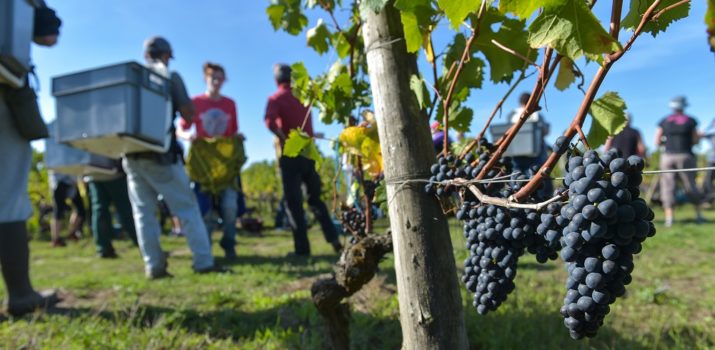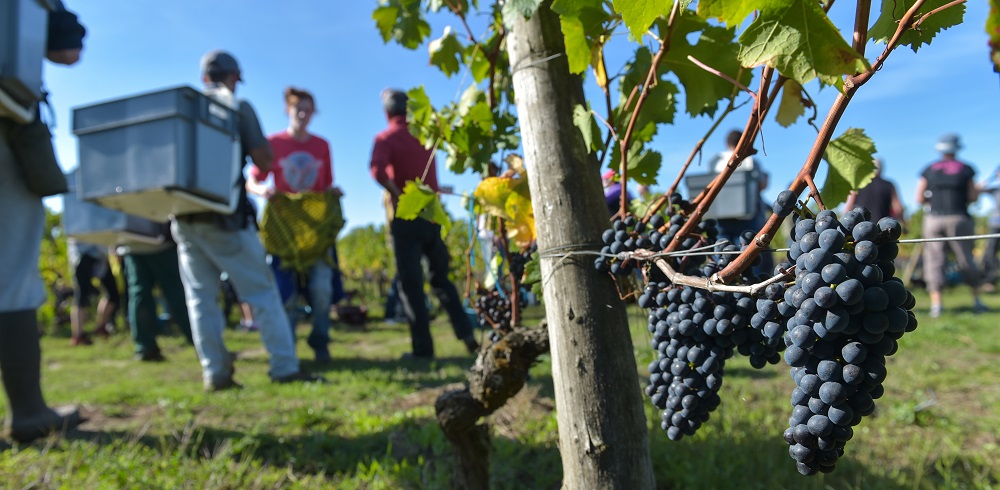

This is part of our special feature on Food, Food Systems, and Agriculture.
Throughout the last decade, the global world of wine has seen a radical transformation, defined by the emergence of the concept of terroir as a space for renegotiation of past, present, and future ways of producing, selling, and consuming wine. But what is terroir? And why is it attracting so much interest from academics, producers, experts, and wine consumers? Moreover, what does it tell us about our society, modernity, and world views? And what does the terroir window reveal about the new wine world order? As wine has served as the model for linking product and place together as part of the Geographical Indication (GI) regime for European food and foodstuffs, the question “what does terroir do to wine?” is of crucial importance.
The concept of terroir, whose history is often traced back to its alleged birthplace, France, has a complex genealogical background. Historically, terroir refers to an area or terrain, usually rather small, whose soil and micro-climate adds distinctive qualities to food products. It is, first and foremost, a powerful idea that foregrounds a sense of place, and more recently, taste, to a unique environmental and human site. Some commentators believe it found its original meaning with the emergence of Russian pedology as science of the soil: “Pedology originated in Russia in 1879 and was introduced to France in 1934 by French soil scientist Albert Demolon” (Bérard, 2016: 73). For others, terroir has long been a staple of French discourse and its more recent resonance on a global scale is testament to its power and capacity for myth making (Parker 2015).
In his recent book, Tasting French Terroir: The History of an Idea, Thomas Parker (2015) takes us through the cultural mythology of the natural world developed between the Renaissance and the Revolution and expressed through a wide range of cultural forms from paintings to literature, language, and horticulture. This crafted mythology attached to the power of place, spanning different centuries and now continents, as it has been largely borrowed and translated in other geographical settings, tells a story of rootedness, time, and space, as well as expressions of being and doing in a global setting. It is therefore easy to see why it has been the subject of a lively and expanding academic debate across a wide range of disciplines from geography, geology, history, and anthropology (Demossier 2011 and 2018, Parker 2015; Teil 2012; Trubek 2008; Barham 2003; Moran 2001; Wilson 1998).
Beyond these academic debates, polarized around whether or not nature dictates quality or human actions create cultural differentiation, a more powerful and capitalist idea lies behind the terroir ideology and the recognition of quality in the wine world hierarchy of values. The word is particularly closely associated with the production of wine (Demossier 2011). Provenance has thus become a matter like never before, and new legal regimes have emerged in parallel as a means of establishing and regulating the use of Geographical Indications (GI) in the food industry. Geographical Indications are associated with the protected name scheme, which developed in the European Union during the 1990s as a scheme highlighting regional and traditional food and foodstuffs whose authenticity and origin can be guaranteed. The use of a Geographical Indication may act as a certification that the product possesses certain qualities, is made according to traditional methods, or enjoys a certain reputation, due to its geographical origin. The prototype of wine has undeniably shaped the norms, form, and substance of sui generis GI systems (Gangjee 2017) and this epistemological model brings with it complex challenges. For D.S. Gangjee (2017), a question matters: to what extent can a regime designed around the particularities of wine be adapted to accommodate cheese, charcuterie, coffee as well as crafts and textiles? Yet the idea of terroir, independently of its origin and development, has transformed local ways of doing and engaging with place-making in new and innovative ways.
Terroir as a critical, self-reflexive and polarized set of ideas shaped by world views: between producing and crafting
The ethnography I have conducted over thirty years in the emblematic terroir region of Burgundy has led me to argue that the defense of cultural differentiation based on human actions and reason, rather than superior natural endowment, is the key to understand terroir (Demossier 2018). It provides a better meaningful, principled manner in which the link between product and place can be conceptualized to accommodate categories of subject matter. In relation to wine as a commodity, the consumer very rarely asks what is behind the bottle, and often place, grape, or reputation are evoked masking any properly informed discussion about what you drink. Considering that, since the Second World War, the wine industry has been amongst the largest consumers of agricultural chemicals, it is interesting to notice how powerful the mythology of terroir has been in presenting a convincing story about nature, place, and taste (Black and Ulin 2013). Indeed, nature has been constructed through terroir as the paragon of quality to contrast with the technical domestication, which dominated wine production since the 1960s with the intensive use of pesticides and other chemicals. A new generation of young and educated wine producers has started to question the terroir ideology, especially that incarnated by the French INAO (previously Institut National des Appellations d’Origine which has become the Institut national de l’origine et de la qualité, guardian of the values), and new, more environmentally friendly practices and discourses have emerged within the most traditional and reputable wine regions. As a consequence, the idea of taste attached to a place has come under scrutiny in local professional circles.
In Burgundy, the transformation of viticulture and the economic position of the vigneron explained, in part, by globalization and wider social and economic change, have contributed to a more critical approach to wine production. An increasing number of winegrowers have had access to higher education and, consequently, are eager to learn and to produce better quality wines by resisting standardization in wine making techniques and emulating quality. It is undeniable that a more engaged philosophy defines French wine production even in the most emblematic regions. Prices of Burgundian grands crus were rising constantly throughout the 1990s, as were the land values and the prestige attached to specific plots at the top of the scale. This created a new relationship between the producers and their plots seen as potentially part of the local family heritage, but being given a heightened global value with the recently conferred UNESCO world heritage status in 2015. This process of gentrification and increased economic prosperity brings its own challenge in terms of sustainability and the transmission of core values such as work pertaining to traditional wine communities. Tensions between producing and crafting have become more polarized and visible.
Access to international markets and the kudos of prestigious restaurants serving your wines is no longer a question of social class and status, but is increasingly dependent upon connections, friendships, lifestyles, and negotiations. This global commodification has benefited the wine producers, but it has also placed more pressure on those who wish to maintain their position in the market. In Burgundy, until recently, terroir was the key to explaining quality to both national and global wine consumers, but today the new narratives of climats, craft, and artisanship have found their way into consumers’ everyday understanding of global difference as well as into international, national, local, and individual constructions of identity. The concept of the climats de Bourgogne was invented locally in an attempt to renew the terroir ideology while positioning Burgundy wines in the context of an ever more globalized world of wine, which has increasingly questioned the hierarchy attached to traditional regions of production. The climats are defined as Burgundy’s own version of the terroir, with the term taking on a different sense to that usually associated with soil, exposition, and meteorological conditions. According to the dossier, “they are particular to Burgundy and designate a parcel of land dedicated to a precisely delimited vineyard, known by that name for hundreds of years, and therefore a precise plot, soil, subsoil, exposure, microclimate, and forming together within a vineyard characteristics that constitute a personality, unique to one terroir and one cru.”[1] This increasing quest for differentiation reflects the growing fragmentation of the wine market in terms of consumers’ segments, and the rise of individualism attached to neo-liberal and post-colonial settings. In this new context, Burgundy incarnates tradition, unchanging time and authenticity while playing the diversity card with its 1247 climats (Demossier 2018). Globalization and the expansion of the market for premium wines attached to monopoly rent have thus enabled social actors to imbricate themselves in a reflexive fashion in a politics of scale where local and global respond to each other and where individual strategies have come to the fore. In this game, authenticity means wealth and money (Warnier 2013), but for some it is also a way of being “true to yourself.”
Another emblematic French wine region, the Languedoc, has managed remarkably well to extract itself from the terroir ideology at a certain human political cost, but its recent success is an illustration of its determination to escape the trap of producing plonk by crafting its own story. Languedoc has generally been seen as a victim of the emerging national wine hierarchy, which, since the eighteenth century, progressively established itself around the debated concept of quality. Unlike Burgundy, which relied on its folklore and confraternities to rally the winegrowers around quality in the inter-war period (Laferté 2006), Languedoc experienced wine crises throughout the post-war period. These crises provided the bedrock to a story of radicalization and resistance against any external market forces (Smith 2018). Its story echoes some of the current debates in the global industry around notions of authenticity or artisanship, ecological and environmental concerns as well as the winegrower as the new hero of our modern times. Languedoc wines contributed to the reframing of new forms of economic alternatives to respond to globalization and it has become a key player in the discussion on quality, artisanship and terroir.
The New Zealand wine industry seems to have had little in common with that of Burgundy or Languedoc, which could be defined as almost hermetically sealed in its own materiality, temporality, and self-experience. Central Otago, on the other hand, could be seen as open, soaking up external influences. Yet what both areas have in common is the global wine industry defined by capitalism, as well as consumers cultivating “differential distinction.” In this global context, they started from different historical positions, which explains, in part, where they are now in the pursuit for excellence. In Burgundy, the AOC system (Appellation d’Origine Contrôlée regulated by the INAO) has put constraints on local viticulture and its capacity to innovate, borrow or change, while in Otago the lack of a legal framework means that innovation is an intrinsic part of the global competition for excellence. The AOC or Appellation d’Origine Contrôlée is the French certification granted to certain French geographical indications for wines, cheeses, butters, and other agricultural products, all under the auspices of the government bureau the INAO. It is based on the concept of terroir originally developed in the wine sector. The existence of specific networks of producers-buyers-wine critics-consumers attached to the production and the commercialization of wines worldwide has created the conditions for encouraging differentiation and “distinction.” Marketing, but more importantly, “taste” as a social experience, is central to the process of identifying specific networks. Otago’s place in the global wine hierarchy is still being defined and its pathway is complex, and it is still in the process of writing its own story. Yet, eighteen wine regions were recently registered under the Geographical Indication Act as a way of protecting the wine industry while acknowledging that “(the New Zealand’s GI system) does not, in any way, impose European-style growing, production, or winemaking restrictions”.[2]
The rise of individualism, the art of crafting and the disintegration of the social?
Interestingly enough, the production, distribution, and consumption of wine have all been transformed in profound ways by and through globalization, which is itself made up of multiple and often contradictory dynamics (Inglis and Almila 2018). As part of broader shifts, terroir discourse and terroir marketing have come to dominate the global wine industry relegating the wine industrials to a marginalized position while still providing consumers with a substantial economic segment of the overall worldwide wine production. The world’s ten biggest wine producers such as E. and J. Gallo or Constellation cover 15 percent of the world production while only two French companies, Castel Frères and Pernod Ricard, feature in this global ranking. It remains difficult to decipher their visibility as they all produce wines under a multitude of brands rather than under their own name. The last three decades have seen the growing visibility of the winegrower as the incarnation of a new and modern rural world where sociability, time and space take on a new significance. Wine growing is one illustration of modernity, with its ordered understanding of the world, its interpretations and questioning of our surroundings, and its dependency on technology. That insight is implicit in the moment of drinking wine itself, though different people do also have differing levels of recognition of it. In this way, when sharing what we take to be a simple glass of wine, people also share an encounter, a moment of recognition that includes often unsaid information, and levels of understanding of each other. It is partially because of this that we can make the claim that vignerons are mediators of modernity. Their work is an expression and enactment of modern culture, and it becomes a means through which our encounters with each other can be mediated too. This specific social experience is encapsulated through the sharing of a bottle of wine and through the art of conversation which goes beyond the taste of place.
Yet, these global trends are also part of a story of capitalism in which both successes and failures are associated with place even in the most reputable parts of the world of wine. The 2015 world heritage status of wine landscape given to Burgundy has given a new impetus to the protection of tangible and intangible heritage. The region has launched a project “la cité des vins”[3] echoing the Bordeaux wine project. In Beaune, regional capital of Burgundian wine industry, the majority of the local independent retailers devoted to clothes, food, jewelry, and digital technology have recently disappeared, giving way to wine shops, luxurious gastronomic and artistic temples, restaurants, and four-star boutique hotels. The last decade has witnessed a growing number of predominantly Western European viticultural sites seeking their recognition as World Heritage landscapes or cultural sites as well as the emergence of a new category of perception, that of “wine landscape.” Both phenomena are part of a global shift, which has transformed wine landscape into another competitive element of differentiation in the global hierarchy of value attached to the world of wine. In a recent article, Maria Gravari-Barbas (2014) argues that the new winescape might be seen as a reflection of the intense modernization of our societies. The author operates a parallel between trends in the winescapes and those that characterize central metropolitan areas or international elite resorts and she cites three significant trends: the era of artist capitalism; the incursion of the marks and labels transforming the winescapes into brandscapes; the role that tourism plays in these transformations.
Central to those trends remains the understanding of the relationship that contemporary societies maintain between culture and nature (Gravari-Barbas 2014). Our contemporary societies are characterized by changing relationships between nature and culture and utopias play a central role in enabling the negotiation of what could be still seen and understood as “natural” (Demossier forthcoming). An on-going struggle to reconcile the productive ideal and actual terroir is now part of the local political, social, and cultural narrative. On the one hand, the process of heritagization of the site has heightened the constraints under which wine producers engage with nature, creating new challenges which will be addressed in a wide range of ways, from the management of waste water to producing solid organic waste that is often similarly mishandled. On the other hand, vineyards are far from being natural as they are one of the most crafted pieces of agricultural land and managing them is far from a collective and standardized process.
Beyond these changes lie further processes full of contradictions, ambivalences, and controversies (Inglis and Alimila 2018). It can be argued that wine as a commodity encapsulates remarkably well the paradoxes of our modernity. It also tells us a story about the loss of collective values but its re-imbrication under different forms and shapes in other social settings or in other scales. “Local” in this context has acquired a new global resonance with a pejorative twist attached to the description of those who have remained too attached to the locality: “X is still very traditional, he is a terroirist, he does the same as his father” while economic success could paradoxically be seen as the way to be more rooted, because of the local economic impact it has on the community. Terroir as an idea incites collective thinking and critical engagement. When terroir politically became a legal frame in the 1930s it was mainly in relation to improving quality and fighting frauds while creating a community of producers around the definition of wine (Barham 2003; Laferté 2006; Fourcade). Following globalization, these definitions have blurred, generating new tensions and conflicts (Demossier 2011) seeing a defensive localism and mythical, exclusionary place-making being challenged. Here are the real dangers associated with the disintegration of the social. Let’s not forget that feasting, which includes eating and drinking, is one of the cornerstones of heightened sociability and cooperation throughout human history with wine requiring many people to work together.
Marion Demossier is Professor of French and European Studies and Head of the Department of Modern Languages at the University of Southampton. She has previously taught French and European politics and society at the University of Bath. She holds a PhD in Social Anthropology from the EHESS (École des Hautes Études en Sciences Sociales) in Paris. She has published more than twenty scholarly articles in leading academic journals in Britain, France and the United-States, including the Journal of the Royal Anthropological Institute, Cultural Analysis, the Anthropological Journal of European Cultures and Modern and Contemporary France. She has also written widely for a student audience, contributing chapters to prestigious series such as A companion to the Anthropology of Europe or Culinary Taste. She has just recently published Burgundy: A Global Anthropology of Place and Taste with Berghahn (2018). She has been involved as an expert with the wine industry in France and New Zealand over a period of twenty years. She is regularly invited to lecture at international conferences and has appeared on both television and national radio in the UK and France to discuss issues related to her work. She sits on the UNESCO Climats de Bourgogne scientific Committee member: http://www.climats-bourgogne.com/ and is a member of the UNESCO network Chair Culture of Wine, Dijon since 2006.
Photo: Workers in vineyards, Grape Harvest, Saint Emilion, Bordeaux, France | Shutterstock
References:
Barham, E. (2003). Translating Terroir: The Global Challenge of French AOC Labelling, Journal of Rural Studies 19: 127–38.
Bérard, L. (2016). Terroir and the sense of place. In D.S. Gangjee. Research Handbook on Intellectual Property and Geographical Indications. Cheltenham, UK: Edward Elgar Publishing: 72-92.
Black, R and Ulin, R. (2013). Wine and Culture: Vineyard to Glass. New York and London: Bloomsbury.
Demossier, M. (2011). 2011. Beyond Terroir: Territorial Construction, Hegemonic Discourses, and French Wine Culture, Journal of the Royal Anthropological Institute 17: 685–705.
Demossier, M. (2018). Burgundy: A Global Anthropology of Place and Taste. New-York and Oxford: Berghahn.
Demossier, M. (forthcoming). Burgundy’s climats and the utopian wine heritage landscape. In Jacqueline Dutton and Peter Howland (eds). Making New Worlds:Wine, Terroir, Utopia. London: Routledge.
Fourcade, M. (2012). The Vile and the Noble. The Sociological Quarterly 53: 524–45
Gangjee, D.S. (ed). (2016) Research Handbook on Intellectual Property and Geographical Indications. Cheltenham, UK: Edward Elgar Publishing.
Gangjee, D. S. (2017). GIs beyond Wine: Time to Rethink the Link. International Review of Intellectual Property and Competition Law 129.
Gravari-Barbas, M. (2014). Winescapes: Tourisme et artialisation, entre le local et le global. CULTUR, ano 08 – nº 03 – Outubro/2014. www.uesc.br/revistas/culturaeturismo.
Inglis, D and Almila, A-M. (forthcoming). The Globalization of Wine: The Trans-Nationalization and Localization of Production, Leisure and Pleasure, London: Bloomsbury.
Laferté, G. (2006). La Bourgogne et ses vins: image d’origine contrôlée. Paris: Belin.
Moran, W. (2001). Terroir – the Human Factor. Australian and New Zealand Wine Industry Journal 16(2): 32–51.
Parker, T. (2015). Tasting French Terroir: The History of an Idea. Berkeley, CA: University of California Press.
Smith, Andrew W.M. (2016). Terror and terroir. The winegrowers of the Languedoc and modern France. Manchester: Manchester University Press studies in Modern French History.
Teil, G. (2012). No Such Thing as Terroir. Science, Technology & Human Values 37 (September): 478–50.
Trubek, A. (2008). The Taste of Place: A Cultural Journey into Terroir. Berkeley, CA : University of California Press.
Warnier, J-P. (2013). La Mondialisation de la Culture. Paris: Editions la Découverte.
Wilson, J.E. (1998). Terroir: The Role of Geology, Climate and Culture in the Making of French Wines. Berkeley, CA: University of California Press.
[1] My own translation. See http://www.climats-bourgogne.com/fr/notre-dossier_17.html. Consulted on 2 February 2016.
[2] https://www.winemag.com/2017/08/04/new-zealand-introduces-geographical-indications-for-18-of-its-wine-regions.
[3] https://www.beaune-tourisme.fr/decouvrir/les-vins-de-bourgogne/les-vignobles-de-bourgogne/la-cite-des-vins
Published on September 5, 2018.




